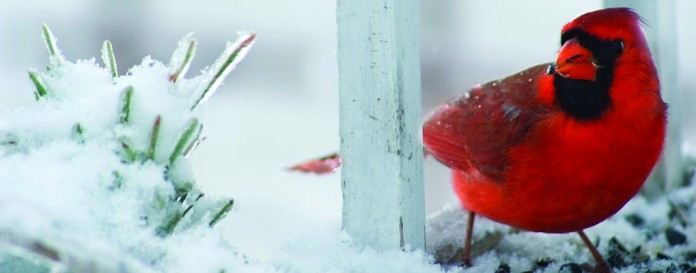Two important citizen science projects – the annual Christmas Bird Count (CBC) and Cornell Lab of Ornithology’s Great Backyard Bird Count (GBBC) – are fast approaching. This year the 116th CBC runs from Dec. 14-Jan. 5, 2016. Volunteers devote one entire day to counting all the wild birds they can find. Local leaders determine the exact date and locations for local counts.
CBC History
It all began on Christmas Day 115 years ago when ornithologist Frank Chapman organized groups of birders to see who could identify, count, and record the most species. Wildlife conservation was in its infancy at the turn of the century; scientists and the general public were just beginning to notice and worry about declining bird populations.
The CBC was one of the first attempts to engage the public in conservation, and it has become the longest running citizen science program in the world. It’s not an exaggeration to say that the first CBC marked the beginning of modern wildlife conservation.
New birders. Though skilled birders form the backbone of CBCs, beginners are always welcome. CBCs are a great way for first time birders to learn how to identify birds in the field and make real contributions to science. Relatively new birders have a good chance to see a life bird or two. And it’s free.
Bird data
CBCs provide a snapshot in time of winter bird populations. Information collected over many years is particularly valuable because it illuminates long-term trends. CBC data is frequently used in peer-reviewed scientific publications and has been used to link bird population declines to climate change. Last year, record numbers of observers participated in CBCs.
Record counts
A total of 72,653 volunteers participated in 2,248 CBCs and counted a total of 68,753,007 birds. Most of the counts took place in the U.S. (1,888) and Canada (460). The remaining 114 took place in Latin America, the Caribbean, Bermuda, and the Pacific Islands. The highest species count came from Ecuador (529).
And don’t be discouraged by inexperience. Count groups are set up so that each group has at least one experienced birder. This insures accuracy of bird identification and enables veteran birders to encourage beginners. To participate in the CBC visit birds.audubon.org/christmas-bird-count and click on “Join the Christmas Bird Count.”
GBBC
A second upcoming bird-related winter citizen science project is the Great Backyard Bird Count (GBBC). The 19th annual GBBC takes place Feb. 12-15, 2016. A joint project of the Cornell Lab of Ornithology, the National Audubon Society, and Bird Studies Canada, the GBBC is an opportunity for all to discover the wonder of birds.
Begun in 1998, the GBBC enlists birders of all skill levels in an effort to keep common birds common by providing a snapshot of midwinter bird abundance and distribution.
Bird counts
Last year GBBC “citizen scientists” from more than 100 countries turned in 147,265 checklists reporting a total of 18,726,079 individual birds and 5,090 species — that’s about half of all the bird species in the world. In addition to the U.S. and Canada, India, Australia, and Mexico led the way with the greatest number of checklists submitted.
In the U.S., California birders submitted the most checklists (8,453), followed by Pennsylvania (7,120), and New York (6,615). The species reported on the most checklists were northern cardinals (59,083), dark-eyed juncos (59,074), mourning doves (48,313), downy woodpeckers (45,399), and blue jays (41,671). The most numerous species reported in the U.S. was the snow goose with 1,494,937 counted.
Anyone can bird
Anyone can participate in the Great Backyard Bird Count, from novice bird watchers to experts. Participants count birds for as little as 15 minutes (or as long as they wish) on one or more days of the event and report their sightings online.
Counts can be done anywhere from the backyard to a local park, nature center or wildlife refuge. It’s easy, free, and fun. During the count, results are updated hourly on animated maps and colorful graphs for all to view. This feedback allows participants to see almost immediately how their observations fit into the continental perspective.
For more information about the GBBC or the Lab of Ornithology, contact the Lab at 159 Sapsucker Woods Road, Ithaca, New York, www.gbbc.birdcount.org, or call 800-843-2473.













